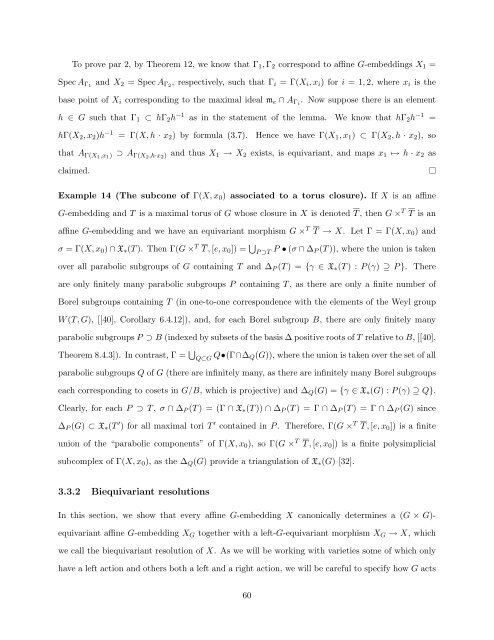Equivariant Embeddings of Algebraic Groups
Equivariant Embeddings of Algebraic Groups
Equivariant Embeddings of Algebraic Groups
Create successful ePaper yourself
Turn your PDF publications into a flip-book with our unique Google optimized e-Paper software.
To prove par 2, by Theorem 12, we know that Γ 1 , Γ 2 correspond to affine G-embeddings X 1 =<br />
Spec A Γ1<br />
and X 2 = Spec A Γ2 , respectively, such that Γ i = Γ(X i , x i ) for i = 1, 2, where x i is the<br />
base point <strong>of</strong> X i corresponding to the maximal ideal m e ∩ A Γi . Now suppose there is an element<br />
h ∈ G such that Γ 1 ⊂ hΓ 2 h −1 as in the statement <strong>of</strong> the lemma. We know that hΓ 2 h −1 =<br />
hΓ(X 2 , x 2 )h −1 = Γ(X, h · x 2 ) by formula (3.7). Hence we have Γ(X 1 , x 1 ) ⊂ Γ(X 2 , h · x 2 ), so<br />
that A Γ(X1 ,x 1 ) ⊃ A Γ(X2 ,h·x 2 ) and thus X 1 → X 2 exists, is equivariant, and maps x 1 ↦→ h · x 2 as<br />
claimed.<br />
Example 14 (The subcone <strong>of</strong> Γ(X, x 0 ) associated to a torus closure). If X is an affine<br />
G-embedding and T is a maximal torus <strong>of</strong> G whose closure in X is denoted T , then G × T T is an<br />
affine G-embedding and we have an equivariant morphism G × T T → X. Let Γ = Γ(X, x 0 ) and<br />
σ = Γ(X, x 0 ) ∩ X ∗ (T ). Then Γ(G × T T , [e, x 0 ]) = ⋃ P ⊃T P • (σ ∩ ∆ P (T )), where the union is taken<br />
over all parabolic subgroups <strong>of</strong> G containing T and ∆ P (T ) = {γ ∈ X ∗ (T ) : P (γ) ⊇ P }. There<br />
are only finitely many parabolic subgroups P containing T , as there are only a finite number <strong>of</strong><br />
Borel subgroups containing T (in one-to-one correspondence with the elements <strong>of</strong> the Weyl group<br />
W (T, G), [[40], Corollary 6.4.12]), and, for each Borel subgroup B, there are only finitely many<br />
parabolic subgroups P ⊃ B (indexed by subsets <strong>of</strong> the basis ∆ positive roots <strong>of</strong> T relative to B, [[40],<br />
Theorem 8.4.3]). In contrast, Γ = ⋃ Q⊂G Q•(Γ∩∆ Q(G)), where the union is taken over the set <strong>of</strong> all<br />
parabolic subgroups Q <strong>of</strong> G (there are infinitely many, as there are infinitely many Borel subgroups<br />
each corresponding to cosets in G/B, which is projective) and ∆ Q (G) = {γ ∈ X ∗ (G) : P (γ) ⊇ Q}.<br />
Clearly, for each P ⊃ T , σ ∩ ∆ P (T ) = (Γ ∩ X ∗ (T )) ∩ ∆ P (T ) = Γ ∩ ∆ P (T ) = Γ ∩ ∆ P (G) since<br />
∆ P (G) ⊂ X ∗ (T ′ ) for all maximal tori T ′ contained in P . Therefore, Γ(G × T T , [e, x 0 ]) is a finite<br />
union <strong>of</strong> the “parabolic components” <strong>of</strong> Γ(X, x 0 ), so Γ(G × T T , [e, x 0 ]) is a finite polysimplicial<br />
subcomplex <strong>of</strong> Γ(X, x 0 ), as the ∆ Q (G) provide a triangulation <strong>of</strong> X ∗ (G) [32].<br />
3.3.2 Biequivariant resolutions<br />
In this section, we show that every affine G-embedding X canonically determines a (G × G)-<br />
equivariant affine G-embedding X G together with a left-G-equivariant morphism X G → X, which<br />
we call the biequivariant resolution <strong>of</strong> X. As we will be working with varieties some <strong>of</strong> which only<br />
have a left action and others both a left and a right action, we will be careful to specify how G acts<br />
60
















